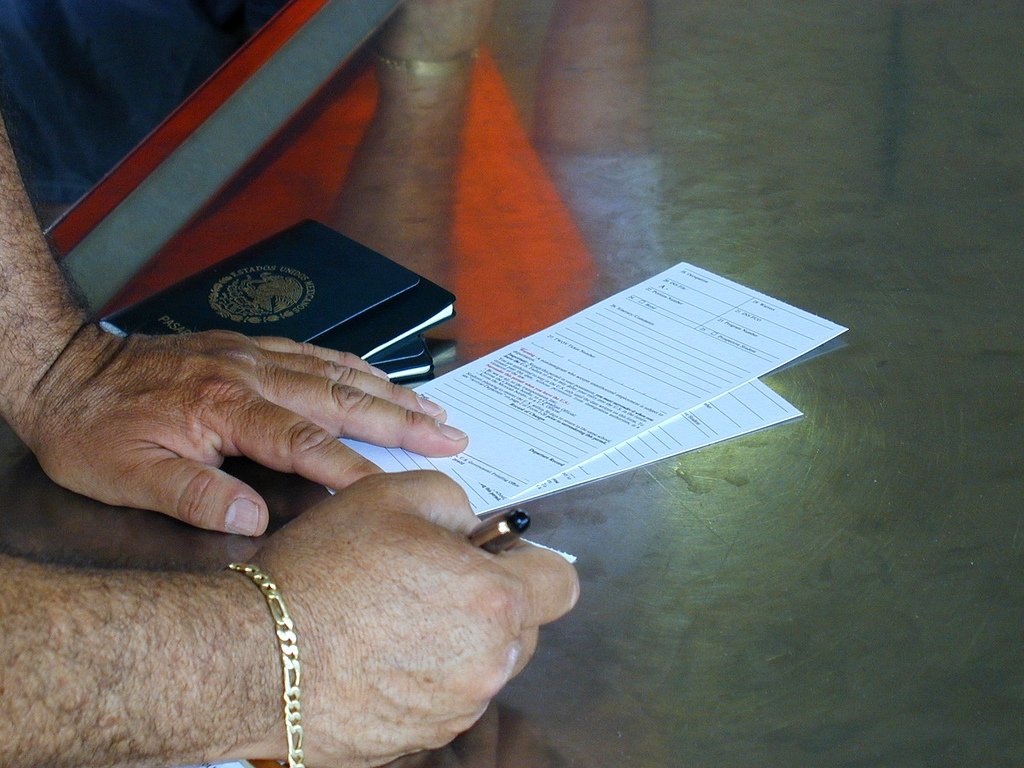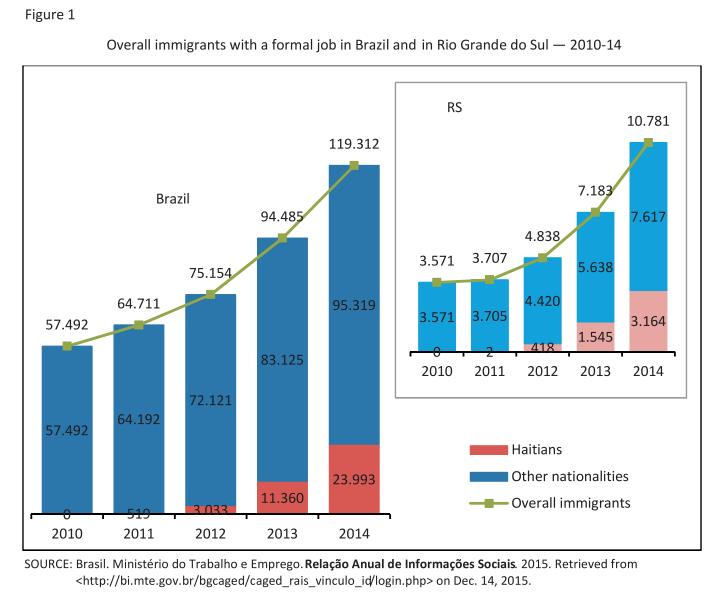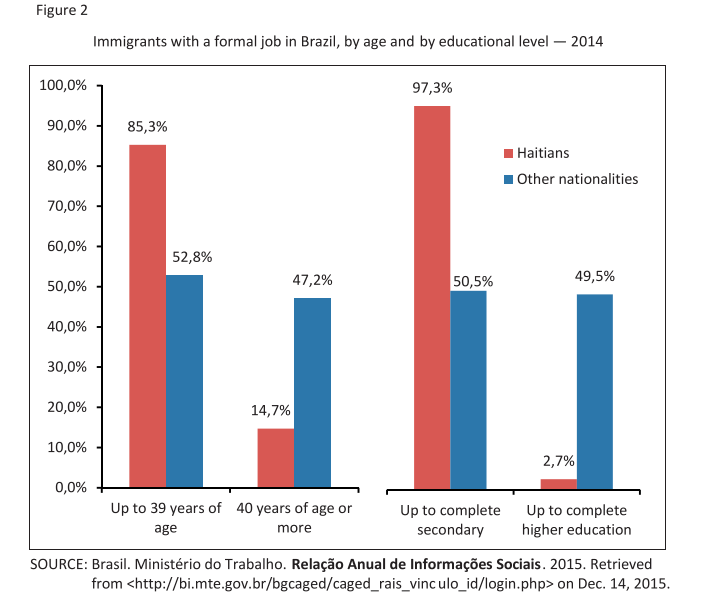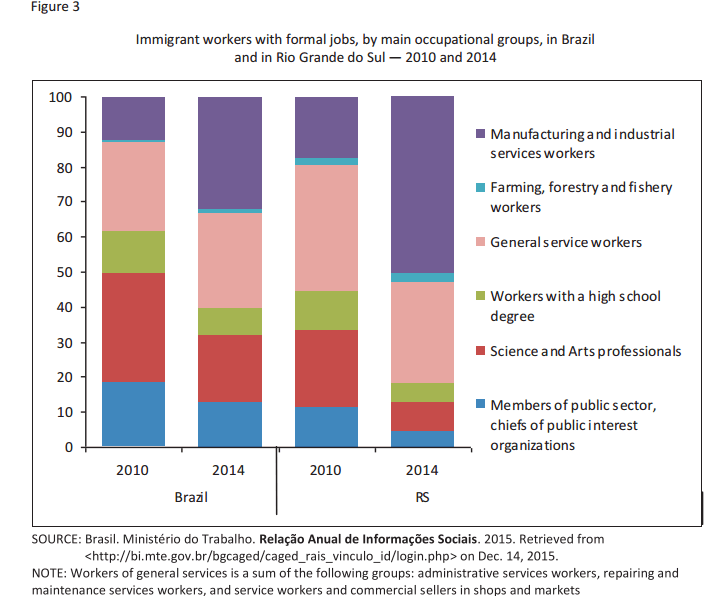The restructuring process of the Brazilian labor market, since 2004, with the creation of formal jobs, has been attracting foreigners. Brazil, which has exported many workers in search of the “American dream”, has more recently represented the “Brazilian dream” for many immigrants, mainly from Haiti. The analysis of permits for foreigners to work in Brazil has revealed this new migratory flow, which has been increasingly visible in recent years.
Based on migration data in Brazil, it is possible to divide the migration phenomenon into two groups: the first one may be named as the regular flow and depends on the level of economic activity, which somehow corresponds to the domestic demand for foreign professionals. According to Coordenação Geral de Imigração (CGIg), an agency of the Brazilian Ministry of Labor and Employment (MTE, the initials in Portuguese), Brazil granted 244,096 work permits for foreigners between 2011 and 2014, of which 95% were temporary and 5% permanent. They were mostly men (89.7%), between 20 and 49 years of age (82.8%) and with a high level of education (55% with bachelor’s degrees and 37% with high school). By country of origin, the United States ranks first in permits (13.9%), followed by the Philippines (9.2%) and the United Kingdom (1.6%). Most U.S. citizens came to attend events, while the Filipinos and the English came to work on board of vessels. São Paulo (43.9%) and Rio de Janeiro (36.9%) were the major destinations. Rio Grande do Sul had 2% of permits in this period.
The second migration flow represents the “Brazilian dream”. They are people who come looking for job opportunities in Brazil, striving for a better life, similarly to thousands of Brazilians who have grown out of poverty in recent years. According to the Conselho Nacional de Imigração (CNIg,) 14,981 permits for foreigners were issued from 2011 to 2014. Among them are work permits, residence permits by family unions and special situations. It is noteworthy that all permits issued by CGIg were of work and 87% of CNIg permits were of special situations. This means that the first group heads to Brazil given their current work, unlike the second one, which arrives in Brazil searching for a job. Regarding the country of origin, Haiti accounts for 63.4% (9,492) of permits by CNIg, all of which were of special situations. According to CNIg[1], there are still 40,000 Haitian processes under analysis.
The movement of Haitians to Brazil started after the 2010 earthquake and has intensified after the issuing of the Normative Resolution 97, of 12 January 2012, which sets forth the granting of permanent visas for humanitarian reasons to Haitian nationals. Haitian immigrants are the only ones to bear this kind of resolution in CNIg, based on Art. 16 of Law No. 6.815, of 1980. It should be noted that Brazil is leading the United Nations peacekeeping mission in that country, the United Nations Stabilization Mission in Haiti (MINUSTAH).
Between 2010 and 2014, 34,887 Haitian refugee requests were recorded, 83% thereof were in the last two years of that period, which means that this flux is recent and may still grow. The Republic of Haiti has 10.3 million inhabitants, of which 80% live in poverty[2]. Moreover, rebuilding the country becomes even more difficult as the younger male and highly educated population emigrates, leaving behind women, children and elderly people and about 40% of illiterates. They arrive in Brazil through a route comprising a flight from Port-au-Prince to Quito, in Ecuador, following a land route crossing Peru, then reaching Brazil, through the State of Acre, then heading to other Brazilian regions in search of jobs.
According to the Relação Anual de Informações Sociais (RAIS), Haiti has ranked first since 2013 in the number of formal workers in Brazil, surpassing Portugal, which, between 2010 and 2012, held the lead. The amount of immigrants with formal contract grew by 107.5% between 2010 and 2014, totalizing 119,312 in 2014, of which 73.2% were men and 26.8% were women. Regarding the country of origin, the top three were Haiti, comprising 20.1% (23,993), Portugal (9.0% or 10,770) and Argentina (6.6% or 7,832). The growth rate of Haitians was 484.4% in 2012, 274.5% in 2013 and 111.2% in 2014. It is noteworthy that Haitian immigrants are younger and less educated than other formal work immigrants.
As for occupation type, the group of sciences and arts professionals, in which 31.2% of immigrants were employed in 2010, shrank to 18.9% in 2014, and the group of manufacturing and industrial services workers increased its share from 12.2% to 31.9% in the same period, according to the Brazilian Classification of Occupations (CBO, the initials in Portuguese)[3]. This implies that the massive influx of Haitians into the Brazilian labor market has redirected foreigners’ employment from sectors requiring high qualification and better wages towards others, which do not demand high educational level and pay lower wages. This migration process has coincided with a favorable moment of the Brazilian labor market, which showed uninterrupted decline in unemployment rates from 2004 to 2014, increasing formalization and growing average of real earnings, especially in those occupations that do not require high educational level.
As for the administrative units, São Paulo is in the lead in the number of immigrant workers with formal jobs, but the trend is that these immigrants are moving to other regions. Remarkably, the South Region had the largest increase between 2010 and 2014 (289.4%). Rio Grande do Sul, where 6.2% of immigrants worked in 2010, had its share raised to 9.0% in 2014, an increase of 201.9% in the amount of immigrants, less than in Santa Catarina (411.1 %) and Paraná (287.5%) over the same period.
According to RAIS, Rio Grande do Sul recorded a continuous increase in the immigrant workforce with a formal contract, from 3,571 in 2010 to 10,781 in 2014. The main nationalities in 2014 were the Haitians, with 29.3% (3,164), the Uruguayans, with 19.0% (2,049), and the Argentinians, with 7.9% (851). These immigrants were men (73.5%), young people up to 39 years of age (70.1%) and with a low level of education (81.3% had up to high school finished). As for occupational group, the state is following the national trend. The group of Science and Arts professionals had its share reduced from 22.0% in 2010 to 8.4% in 2014, whereas the group of manufacturing and industrial services workers increased from 17.3% to 50.5% in the same period. Among the Haitians, the proportion in the latter group was 78.4% in 2014.
For the first half of 2015, the data from the Annual Report of Observatório das Migrações Internacionais (OBMigra, 2015[4]) indicate a positive balance in hiring immigrants in Rio Grande do Sul: 1,878 were employed and 424 were laid off; in Porto Alegre, 362 were hired and 116 were laid off. This suggests that, despite the economic recession and the increasing unemployment rate[5], the labor market was still favorable for this population.
It is worth noting that these data refer only to the formal labor market. Unfortunately, there are no data on the informal market. Yet there has been a remarkable increase of immigrants in local commercial centers, mainly as street vendors, a classic case of informal and unprotected labor.
After 10 years of positive figures, the labor market in Brazil has been rapidly deteriorating from 2015 to date, due to the economic downturn. This makes even harder for the lives of those who left their country in search of the “Brazilian dream” and also affects the integration of immigrants to social life. However, it is necessary to bear in mind that Brazil is facing a demographic transition and that Rio Grande do Sul is among the states at a more advanced stage of this process. This means that, in a few years, there will be more elderly than young people in the active working age population. The influx of immigrants, mostly young, may alleviate this demographic phenomenon. Therefore, an integration policy for foreigners is required in Brazilian society, taking advantage of their knowledge and skills for the development of Brazil, thus restoring growth and creating jobs.
[1] Minutes of the agenda of June 10, 2015, according to Cavalcanti, L. (Ed.) et al. Relatório Anual 2015: a inserção dos imigrantes no mercado de trabalho brasileiro. Brasília, DF: OBMigra, 2015.
[2] United Nations in Brazil. EXCLUSIVO: cinco anos depois do terremoto que destruiu o Haiti, ONU continua apoiando reconstrução do país. 2015. Retrieved from
[3] BRASIL. Ministério do Trabalho e Emprego. Classificação Brasileira de Ocupações. 2015. Retrieved from
[4] Cavalcanti, L. (Ed.) Et al. Relatório Anual 2015: a inserção dos imigrantes no mercado de trabalho brasileiro. Brasília, DF: OBMigra, 2015.
[5] According to Pesquisa de Emprego e Desemprego (PED), the overall unemployment rate in the Metropolitan Area of Porto Alegre increased from 5.9% in 2014 to 10.2% in November 2015. See DESEMPENHO do mercado de trabalho da Região Metropolitana de Porto Alegre em 2014. Informe PED-RMPA, Porto Alegre, ano 23, número especial, 2015. Retrieved from




